Nestled on the northeast coast of Bali lies a laid-back fishing village called Tulamben. This unassuming destination is a haven for divers and snorkelers seeking underwater adventure.
If you are looking for sand beneath your toes and bougie beach clubs then Tulamben is not the place for you. Unlike busier tourist areas in Bali, Tulamben is less commercial and a great place to enjoy a more authentic side of Bali. Here, time slows down as travelers spend their days exploring Bali’s marine wonders, soaking in the sounds of the ocean, and swapping stories over a cold Bintang.
Tulamben’s fantastic marine biodiversity and easy-going vibe are what make it such a special place for visitors and locals alike. Have we piqued your curiosity? In this post, we’ll dive deep into everything you need to know about visiting Tulamben, including the best things to do when you’re in the area.
Where is Tulamben?
Tulamben is located on Bali’s northeast coast in the regency of Karangasem, just north of Amed. The village lies in the shadow of Mount Agung, Bali’s tallest and most striking volcano. Tulamben’s proximity to Mt. Agung influenced its geography, with previous eruptions creating Tulamben’s volcanic, rocky coastline.
Our dive shop is conveniently located in the center of Tulamben, directly across the street from the main entrance to the Liberty Wreck dive site.
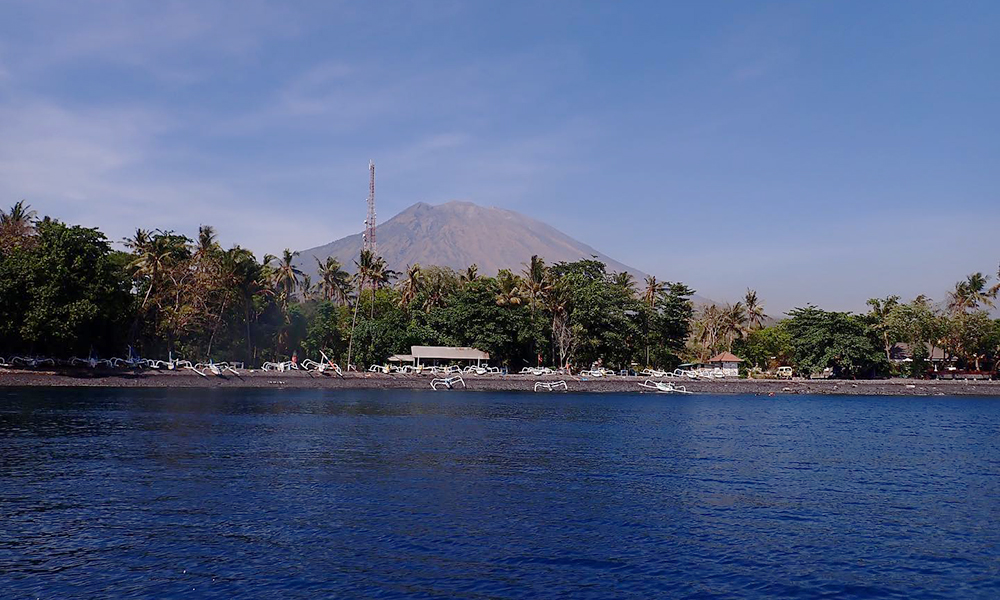
Mount Agung can be seen from Tulamben’s coastline
How to get to Tulamben from Bali
Once you arrive in Bali, the best way to get to Tulamben is by driving. How long this takes varies based on which part of the island you are coming from. Here are some estimations of how long it takes to drive to Tulamben from some of the popular tourist areas in Bali. Keep in mind that timing fluctuates, depending on current traffic conditions.
- Canggu or Uluwatu: 4 hours
- Seminyak, Denpasar, Kuta or Sanur: 3 hours
- Ubud: 2.5 hours
- Lovina: 2 hours
- Padang Bai: 1.5 hours
- Amed: 20 minutes
The best things to do in Tulamben
Tulamben offers a variety of activities, the primary focus being scuba diving. We recommend spending at least a few days in this part of the island and exploring some of the attractions in the surrounding areas. Here are some things to do in and around Tulamben.
Go scuba diving
Tulamben’s main draw is its diverse marine life, with the iconic USAT Liberty shipwreck taking center stage as a must-visit dive site. Torpedoed during World War II, this 120-meter vessel now rests on the ocean floor right offshore. Divers of all levels can explore the Liberty’s coral-encrusted hull and encounter fish, turtles, and other sea creatures darting through the wreckage.
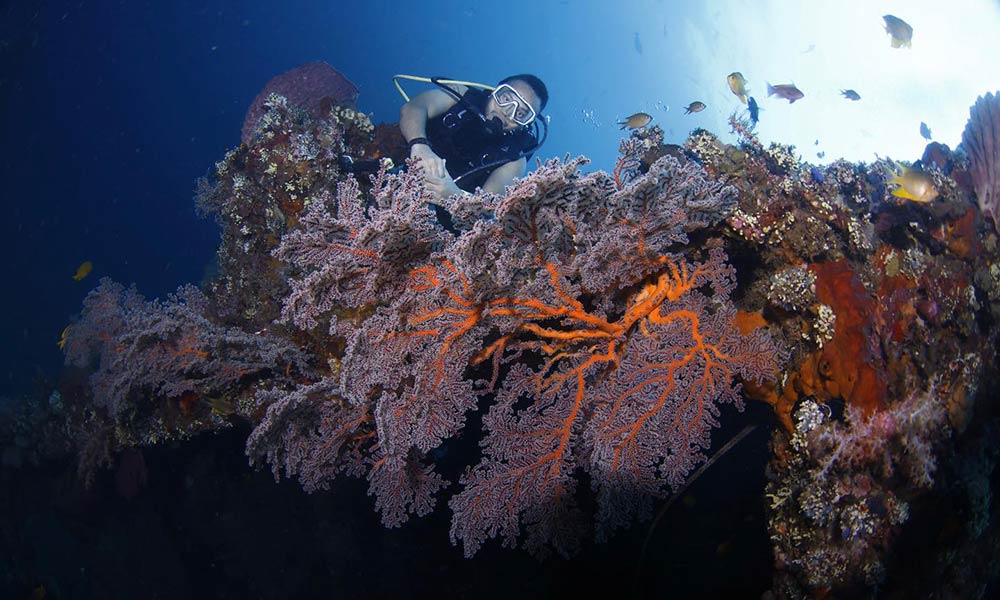
Beyond the Liberty Wreck, there are many other dive sites in the Tulamben area for divers to explore. The Drop Off dive site features a steep underwater wall covered in corals and gorgonians that descends to deeper depths. Coral Garden offers a glimpse of artificial reef restoration in action as well as many fish swimming about a large anemone field. Various muck diving sites allow divers to spot unique critters such as ghost pipefish, frogfish, and various species of nudibranchs. There is also a second, more intact shipwreck located just north of Tulamben which offers a different wreck diving experience to the Liberty Wreck. The dive sites in Amed, such as the Pyramids, Amed Wall, and Japanese Wreck, are also accessible from Tulamben.
Tulamben has a range of dive resorts, shops, and facilities. Whether you’re a beginner or an experienced diver, there are options for guided dives, equipment rental, and diving courses. We recommend going with a locally-owned and operated dive shop such as Let’s Dive Tulamben, to ensure your guide is knowledgeable about the different sites and where to spot marine life. By choosing a local dive center, you’ll also support the local community and economy.
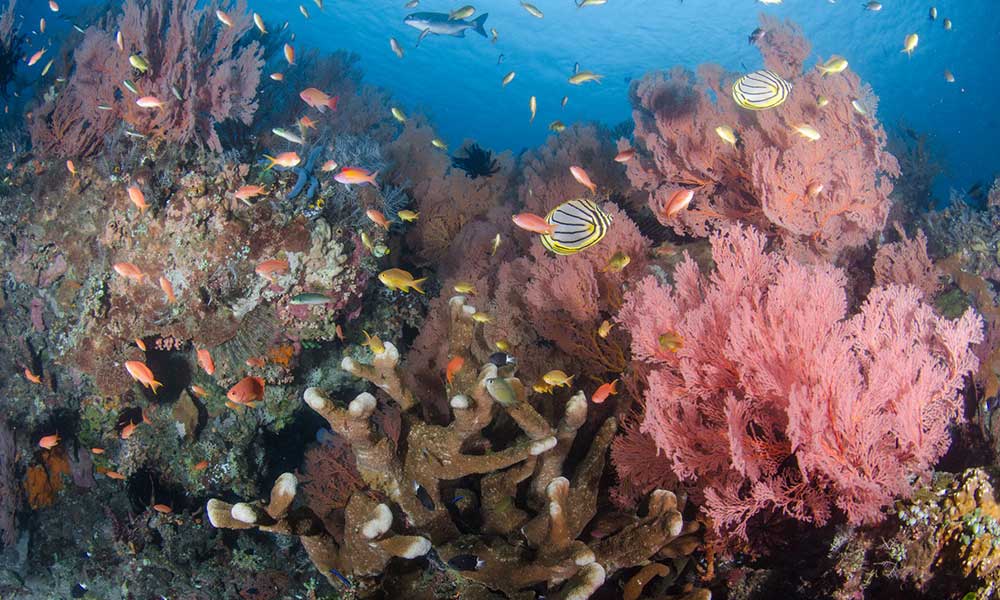
Tulamben’s shallow dive sites and calm waters make it a great place to try out diving for the first time. If you’re a beginner, consider signing up for an introductory dive experience, also known as the PADI Discover Scuba Diving course. You’ll receive a brief orientation to scuba equipment and safety principles and practice skills in shallow water, before embarking on a dive supervised by a certified guide.
Those looking to take their scuba skills and knowledge to the next level can pursue their Open Water Diver or Advanced certification. These multi-day courses include knowledge development as well as hands-on skills training in the pool and at Tulamben’s dive sites.
Read our ultimate guide to diving in Tulamben.
Snorkel above the Liberty shipwreck
If you’re not into diving, you can still enjoy the underwater beauty of Tulamben by snorkeling. Many of the marine wonders are accessible from the surface, making it a great option for those who prefer to stay above water. Snorkelers can observe the tropical fish that swim above the USAT Liberty shipwreck and even see parts of the wreck from the surface. Thanks to its shallow depth, the Coral Garden is also suitable for snorkeling above a mix of natural reefs and artificial statues.
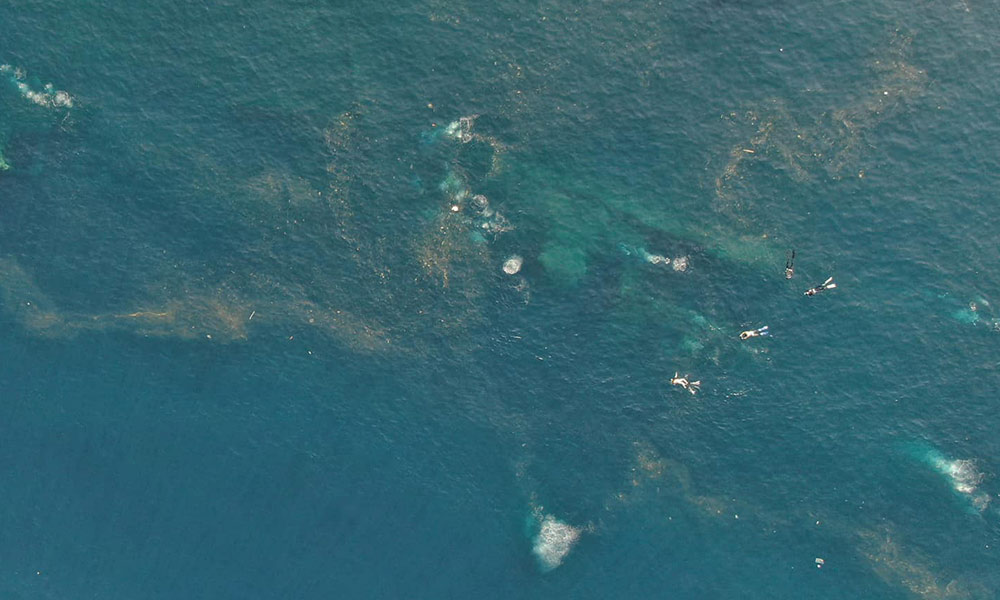
Alternatively, it is also possible to rent gear and go on your own. For the optimal experience, we recommend going with a local guide who can show you the best areas, help identify marine life, and ensure conditions are safe.
Catch your own fish with a local fisherman
While diving may be the most sought-after tourism activity in Tulamben, fishing is also a core part of local life. It’s impossible to miss the traditional outrigger fishing boats, or jukungs, that line Tulamben’s beach. For generations, Tulamben’s families have relied on fishing for sustenance and to make a living.
You can immerse yourself in the local fishing culture by joining a fisherman on one of their daily expeditions. During the fishing tour, you’ll go out in a jukung, learn about artisanal fishing methods, and have a chance to catch fish like tuna, mackerel, and mahi mahi. Since the boats depart in the dark, you’ll also get to watch the sunrise while out at sea. Bring your catch back to our dive shop and we’ll barbecue it up so you can enjoy a fresh seafood lunch or dinner.
Watch the sunset or sunrise
Since Tulamben faces east, it is an excellent place to watch the sunrise over the horizon. As the sun gradually ascends over the sea, it paints the sky with vibrant shades of pink, orange, and purple, creating a breathtaking panoramic view. The rhythmic sounds of the waves add to the peaceful ambiance. Whether enjoyed from the beach or a seaside resort, witnessing the sunrise in Tulamben is a magical experience.
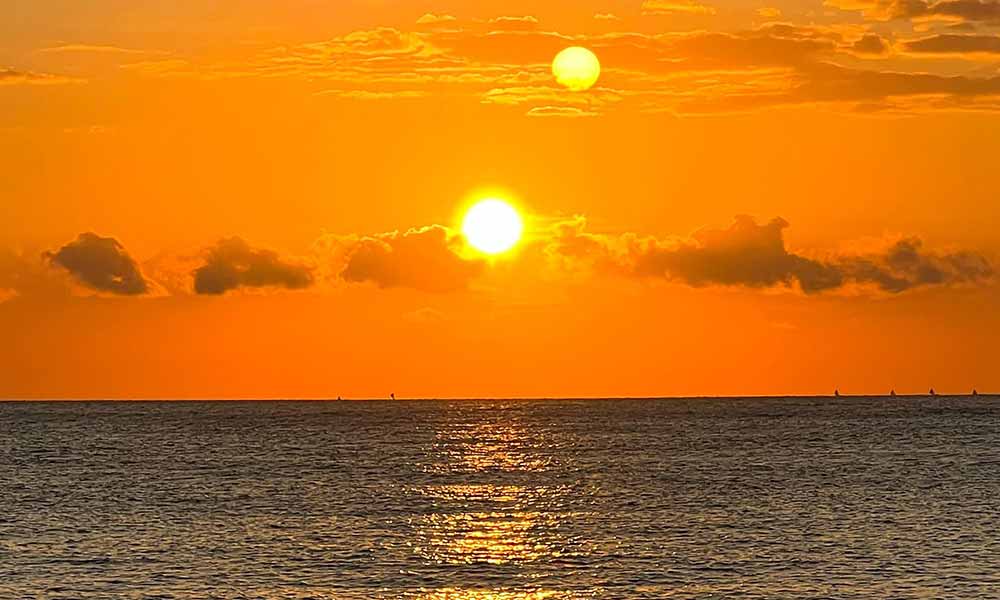
If you’re looking for a more ambitious experience you can climb Mount Batur, one of Bali’s other volcanoes, and watch the sunrise from the top. To climb Batur, you must hire a local guide, depart Tulamben around 2 am, and hike about two hours up the mountain. You’ll be rewarded for your effort with panoramic views from above the clouds as the sun rises over Bali.
For sunset, it’s best to head over to Amed which has various picturesque vantage points. Restaurants perched on the hilltop offer scenic views looking down over Jemeluk Bay where you can see the sun drop behind Mount Agung. There are also numerous beachfront restaurants where travelers can watch the sunset from the comfort of a bean bag chair right on the beach. Watching the sunset in Amed is a breathtaking experience as the sky transforms into a colorful canvas behind the silhouette of Mount Agung.
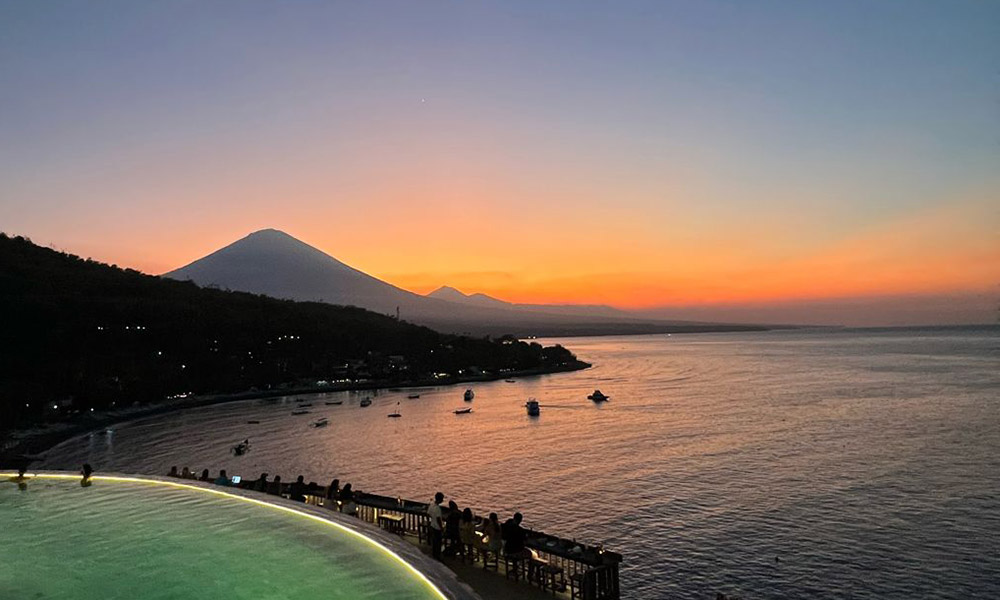
Because Bali is located near the equator, sunrise and sunset times remain fairly consistent throughout the year. In Bali, the sun typically rises between 6:00 to 6:30 am, while the sun sets between 6:15 to 6:45 pm. To make sure you don’t miss it, we recommend checking the timing for that particular day.
Try traditional Balinese cuisine
A day of diving will be sure to work up your appetite. Satisfy your cravings by indulging in Balinese delicacies. Dine at local warungs and restaurants in the Tulamben and Amed area to indulge your taste buds. Be sure to try traditional Balinese dishes like mie goreng or nasi campur that make use of local ingredients and flavors. Read this blog post for a few of our favorite local foods that we think are a must-try during your visit to Bali.

Shop for fresh produce at Tulamben’s local market
To really get a taste of local life, head to Tulamben’s local market. Traditional markets, or pasars, are a hub of activity and a central part of Balinese life. Despite the growth of modern supermarkets, many Balinese people prefer to shop at traditional markets for fresh food products and items needed for ceremonies. Traditional markets are known for offering more affordable prices and many residents prefer the quality and authenticity of the produce available there. They are also communal spaces that are lively with social interaction.
Tulamben’s market is open only in the morning and is located just a few minutes north of town. As you wander through the maze of vendor stalls, stock up on locally sourced foods like tropical fruits, colorful vegetables, fragrant spices and herbs, just-caught fish, and farm-fresh eggs. It is common to see livestock vendors selling animals such as chicken or cattle. If you’re feeling hungry, sample local delicacies like satay skewers, bakso, or nasi campur from the small food stalls. Haggling is the norm here so be prepared to bargain with the vendors. It’s necessary to bring cash because the vendors don’t accept credit cards.
To get the full experience, visit the market on a guided tour. Going with a local guide offers numerous advantages, especially if you are not able to speak the local language. A guide can explain what different products are, help with haggling, and act as a translator since many vendors don’t speak English.
With so many tantalizing commodities, it’s nearly impossible to leave the market empty-handed. Be sure to bring a basket or tote bag to load all your goodies in.
Sing along to live music
While Tulamben may not have a buzzing nightlife scene, we think it’s one of the best places to chill out and kick back. At Let’s Dive Tulamben, we host live music every Wednesday night (and sometimes other days as well!). Stop by our dive shop to listen to our local band play familiar songs. It’s a casual vibe where you can sip on a cold Bintang, request your favorite songs, and chat with locals and travelers. If you’re brave, you can even come up and sing karaoke.
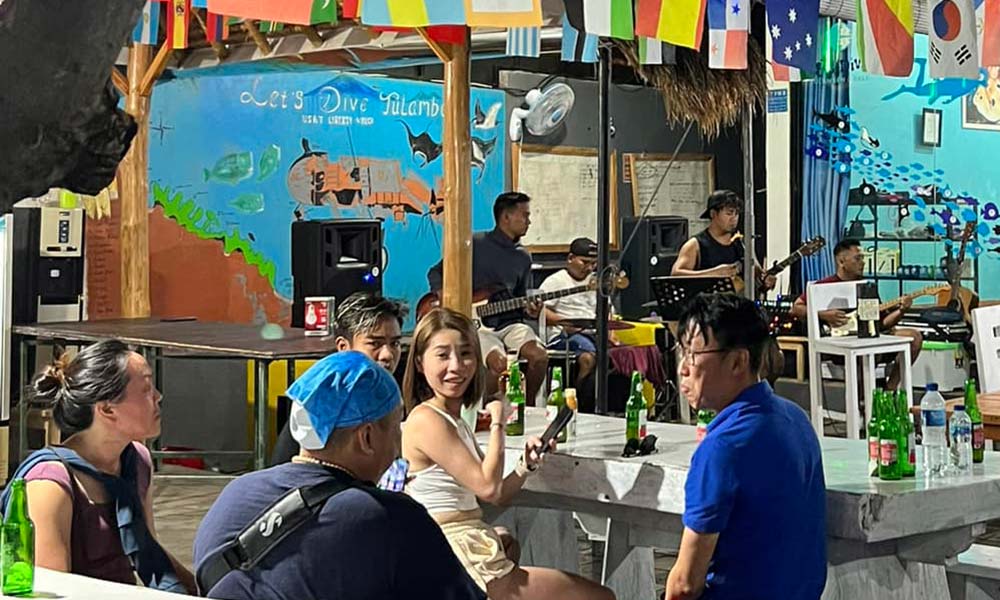
Cool off in Yeh Mampeh Waterfall
If you’re a waterfall lover then you’ll want to add the hidden gem of Yeh Mampeh Waterfall to your list. Commonly referred to as Les Waterfall, Yeh Mampeh is located about 45 minutes north of Tulamben in the district of Tejakula. Because Yeh Mampeh is far from Bali’s main tourist destinations, it is not very crowded and offers a serene experience.
Yeh Mampeh Waterfall cascades down approximately 30 meters over a lush green cliff. Getting to the falls requires a fairly easy 30-minute hike through the jungle, past local plantations. Once you reach the waterfall, cool off by wading in the shallow pool at the base of the waterfall or bathing under the powerful water. On the way back down, stop by one of the local warungs for refreshments like fresh coconut, coffee, chocolate, and fruit.
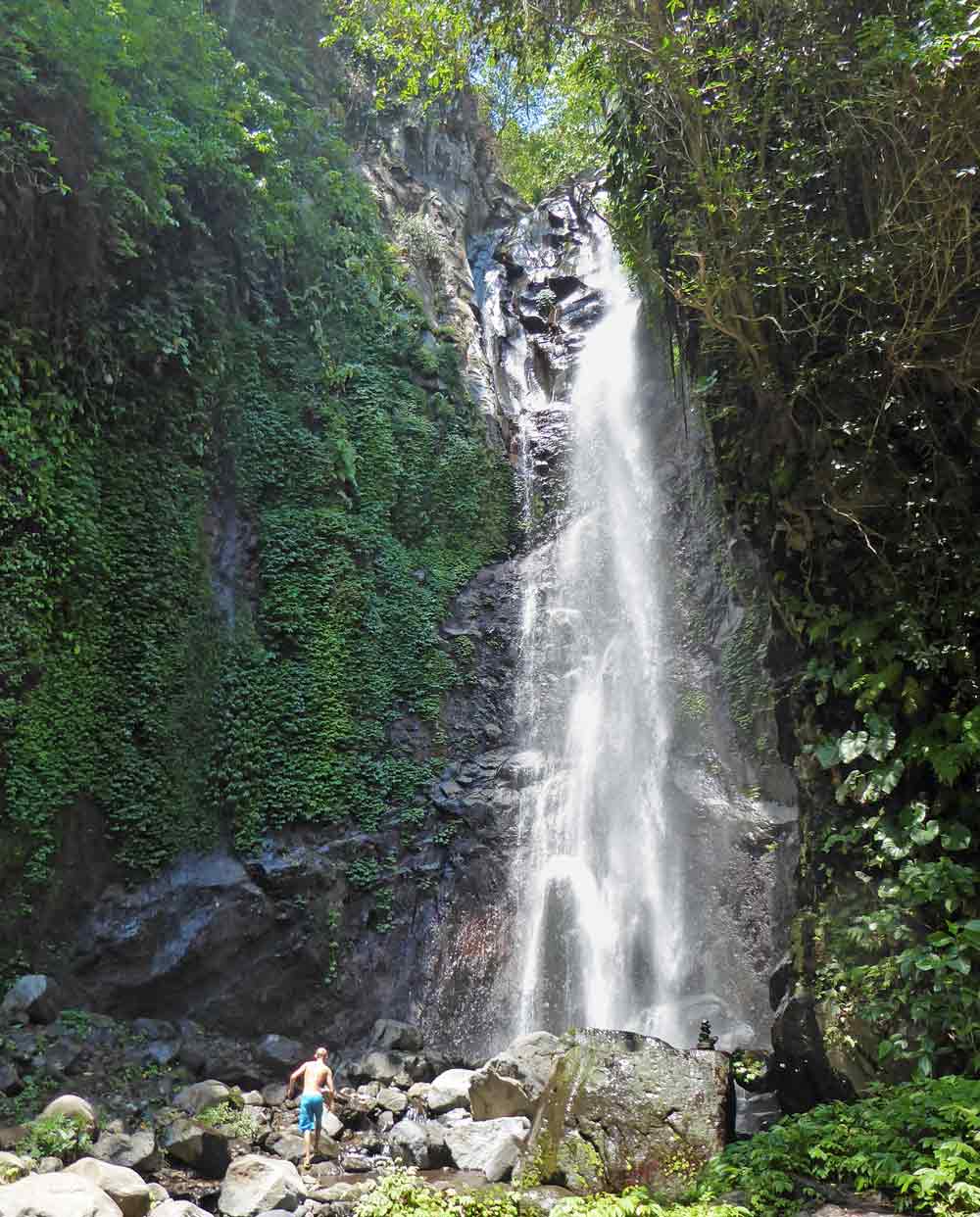
Get pampered at the spa
After a day of diving, unwind and relax with a rejuvenating spa treatment. Spas often incorporate natural ingredients, soothing aromas, and traditional techniques like Balinese massages or flower baths to soothe tension. Many accommodations and resorts in Tulamben feature on-site spas. There are also a few stand-alone spas in Tulamben that offer a more basic experience. More extensive spa options can be found a short drive away in Amed.
Practice yoga with a view
Another great way to release tension is to join a local yoga class. Though there is not much of a yoga scene in Tulamben, some of the accommodations in Amed offer regular classes that are open to the public. Here, you can practice yoga from peaceful shalas overlooking the coastline. What better way to center yourself and nurture your mind and body?
Go to the beach in Amed
Thanks to volcanic eruptions, Tulamben’s beach is covered in smooth, black stones. It’s not the type of place for a typical beach day. Instead, head over to Amed which has a much larger, sandier beach. In Amed, you can spend the day lounging on the dark sand, walking along the long stretch of shoreline, swimming in the calm ocean waters, or sipping on a drink in a beachfront restaurant.
Visit Tirta Gangga water palace
Immerse yourself in Bali’s rich cultural heritage by visiting Tirta Gangga water palace. This heritage site is located about 30 minutes from Tulamben and can be visited on a day trip, or as a stop on your way to/from Tulamben.
Constructed by the king of Karangasem in the 1940s, Tirta Gangga is a former royal palace. The name Tirta Gangga means “water from the Ganges,” a reference to the sacred Ganges river which holds immense spiritual value in Hinduism. As Tirta Gangga is a sacred site, it is advised to dress modestly and behave respectfully when visiting.
The grounds at Tirta Gangga are a picturesque setting, featuring manicured gardens and spring-fed pools filled with koi and adorned with stepping stones, statues of gods, and tiered fountains. Swimming is allowed in designated pools for an additional fee.
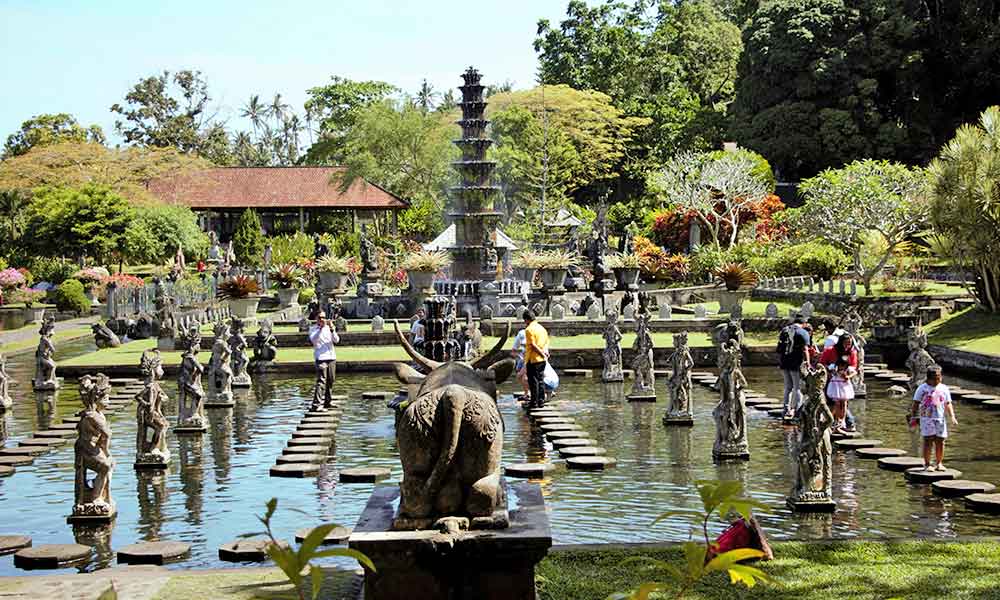
If you’re looking for a bite to eat, there are several Balinese restaurants around Tirta Gangga, some of which offer views over the neighboring rice fields. Tirta Gangga has become a more frequented attraction in recent years thanks to social media. Visit early morning or late afternoon for the best chance of avoiding the crowds.
Trek through the rice fields
When you drive by Tirta Gangga, you’ll be sure to notice the sprawling rice fields in the surrounding area. These green or golden rice fields offer a panoramic view and a glimpse into Bali’s agrarian heritage.
One of the best ways to appreciate these stunning landscapes is by embarking on a guided trekking tour through the fields. As you walk through the rice paddies with a local guide, you’ll likely see farmers tending their fields and learn about the traditional subak irrigation system and the Balinese art of rice cultivation. All the while you’ll be surrounded by some of the most remarkable views in Bali, so be sure to slow down and take it all in.
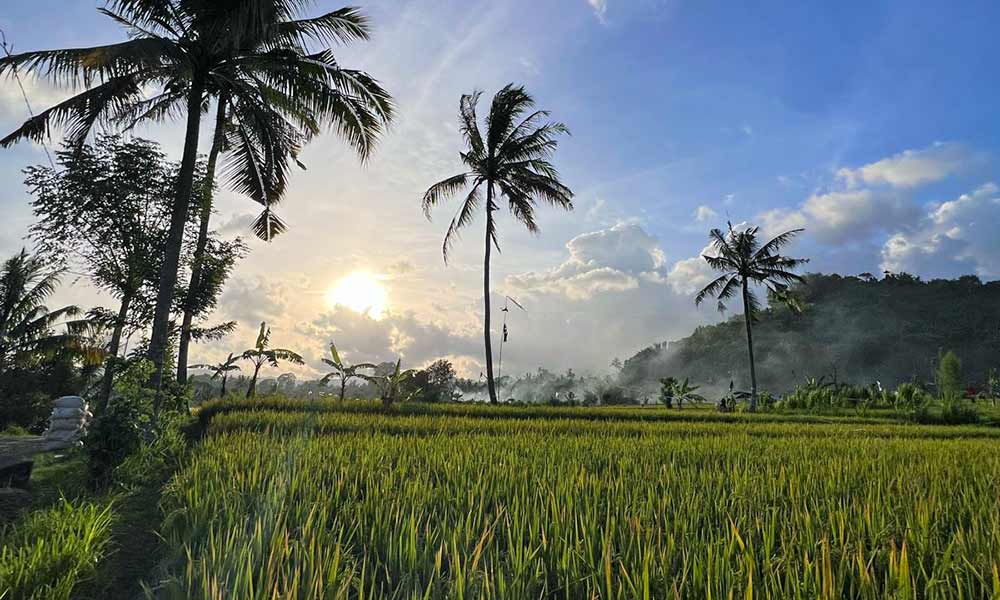
Take in breathtaking views at Lahangan Sweet
Perched above Amed is the region’s newest attraction, Lahangan Sweet. This viewpoint boasts breathtaking vistas of Mount Agung and east Bali’s forested hillsides, rice fields, and coastline. There are various viewpoints at Lahangan Sweet, the most iconic being an elevated treetop platform.
Reaching Lahangan Sweet is a journey in itself. The last stretch of the road is rough, slippery, and steep, so you will need to park your car in the lot before the dirt road. You can either hike the remaining stretch or hire one of the many jeep taxis to drive you up.
Head over to the Gili Islands
Continue your holiday with a trip over to the Gili Islands. The Gilis are a trio of small islands – Gili Trawangan, Gili Air, and Gili Meno – located off the coast of neighboring Lombok. Amed is closer to the Gilis than any of the other departure points in Bali with fast boats departing daily from the harbour. It takes about an hour by fast boat to get from Amed to the Gili Trawangan.
Each of the Gili Islands possesses unique charm, from the lively atmosphere of Trawangan to the serene ambiance of Meno. In the Gilis you can continue your diving or snorkeling adventure or engage in other activities. The Gilis are car-free, so renting a bicycle is a popular way to explore the island at a leisurely pace. Spend your time exploring the sea, relaxing on the beach, watching epic sunsets, or partying the night away.
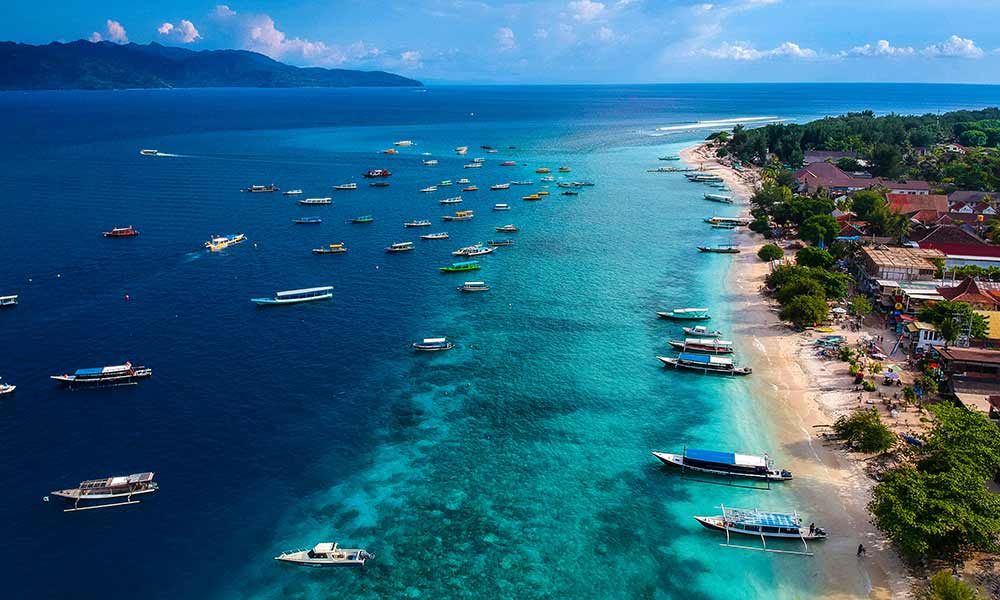
Where to stay in Tulamben
Tulamben offers various accommodation options catering to different preferences and budgets. There are many dive resorts located in Tulamben, which have on-site dive centers, equipment rental, and dive guides. Tulamben also has beachfront villas and bungalows that provide a more intimate setting, allowing guests to enjoy the coastal ambiance. Many of these establishments provide amenities such as swimming pools, spa services, and restaurants. A range of basic guesthouses and hostels provide a budget-friendly option for travelers.
When choosing your accommodation, it’s important to consider whether or not you will have a vehicle. If you don’t have a scooter or car, consider staying somewhere closer to the center of Tulamben which will allow you walkable access to dive shops, mini marts, and local restaurants.
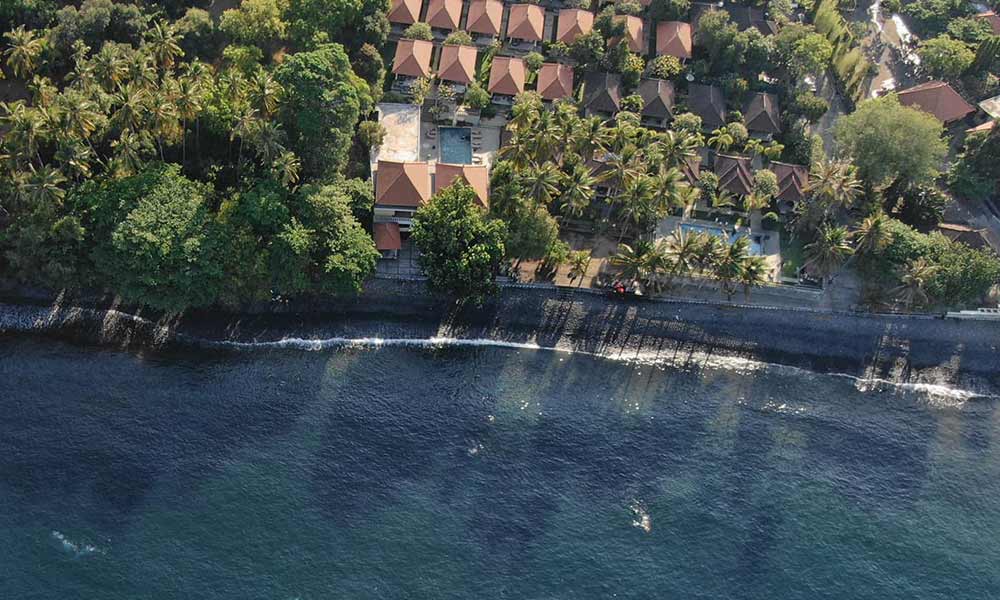
Some travelers choose to base themselves out of Amed, visiting Tulamben during the day. Choosing between staying in Amed or Tulamben depends on your preferences and interests. If diving is your primary focus or you prefer a quieter, less-touristy atmosphere, then Tulamben is an ideal choice. If you prefer a wider range of restaurants and hotels, more nightlife and tourists, and a sandy beach, then Amed may be more up your alley. At Let’s Dive Tulamben we offer free pickup for our customers who stay in Amed, just keep in mind that you will need to allow an extra 20 or so minutes each way.
Is it better to pay with cash or credit cards in Tulamben?
While most hotels and dive shops in Tulamben accept credit or debit cards, many smaller restaurants, local vendors, drivers, and guides only take cash. It’s also handy to have cash on hand to tip your dive guide or other service providers. Paying with cash can also be advantageous because there is typically an additional fee for card transactions.
When paying it cash it is best to carry Indonesian Rupiah, the official local currency. This can be withdrawn from ATMs or money changers in different locations across the island.
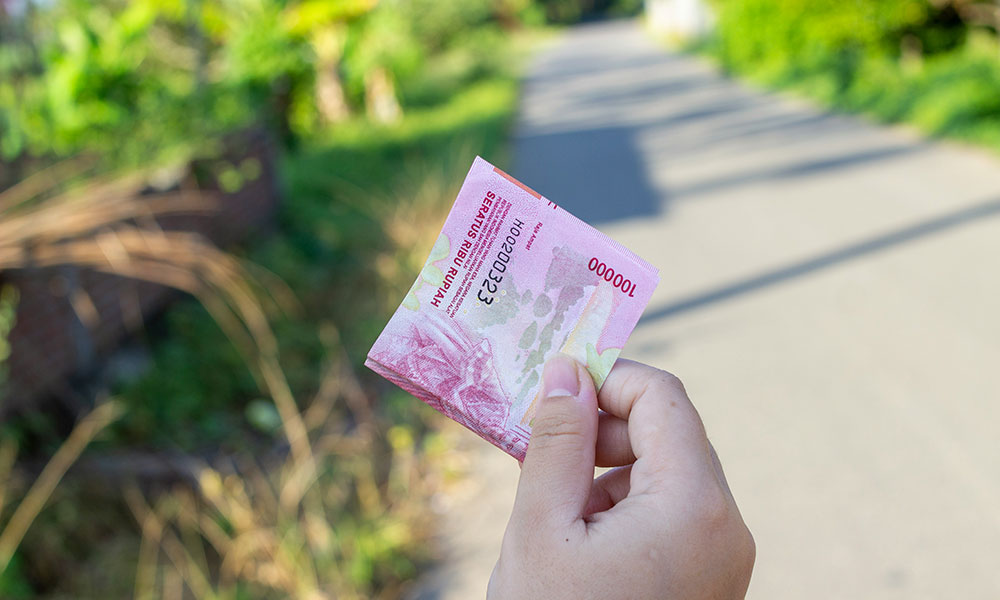
Are there ATMs in Tulamben?
As of February 2024, there is one ATM in Tulamben. This ATM is located in the Indomaret shop, just a few minutes walk from our dive shop. The next closest ATMs are located in the nearby towns of Amed and Kubu. We recommend checking Google Maps to view which ATMs are currently operating.
See you in Tulamben
We hope this guide is a helpful resource for planning your trip to Tulamben. If you are looking to dive or snorkel during your visit to our corner of the island, be sure to send us a message to book your experience.




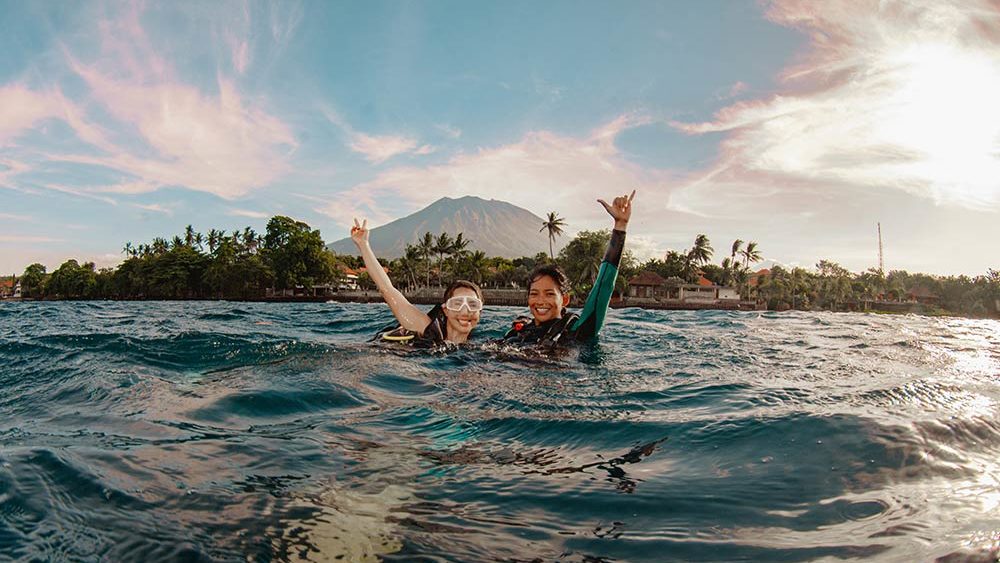

Comments are closed.